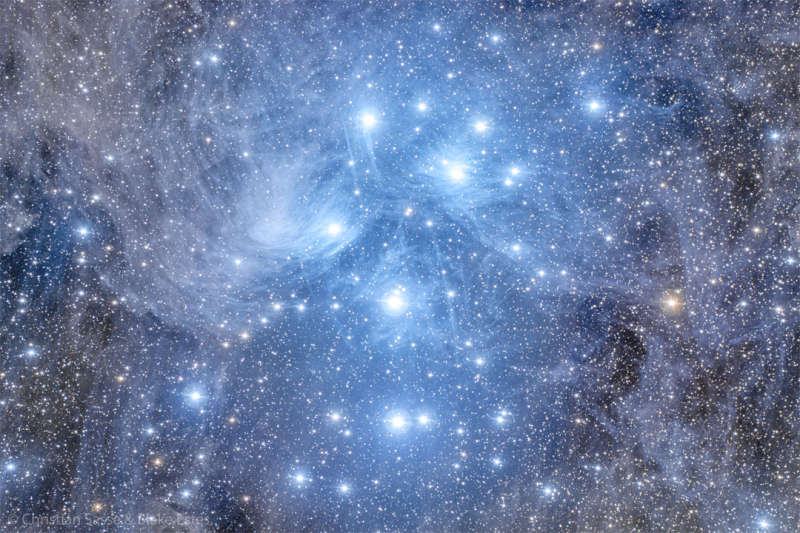Credit & Copyright: Blake Estes
(iTelescope Siding Spring Obs.) &
Christian Sasse
Explanation:
Have you ever seen the Pleiades star cluster?
Even if you have, you probably have never seen it as large and clear as this.
Perhaps the most famous star cluster on the sky, the bright stars of the
Pleiades
can be seen with the unaided eye even from the depths of a
light-polluted city.
With a long exposure from a dark location, though,
the dust cloud surrounding the
Pleiades star
cluster becomes very evident.
The featured 11-hour exposure, taken from the
Siding Spring Observatory
in
Australia,
covers a sky area several times the size of the full
moon.
Also known as the Seven Sisters and
M45,
the Pleiades lies about
400 light years away toward the constellation of the Bull
(Taurus).
A common legend with a
modern twist is that one of the brighter
stars faded since the cluster was named, leaving only six of the sister stars visible to the unaided eye.
The actual number of
Pleiades stars visible,
however, may be more or less than seven, depending on the
darkness of the surrounding sky and the
clarity of the observer's eyesight.
Your Sky Surprise:
What picture did APOD feature on your birthday? (post 1995)
1999 2000 2001 2002 2003 2004 2005 2006 2007 2008 2009 2010 2011 2012 2013 2014 2015 2016 2017 2018 2019 2020 2021 2022 2023 2024 2025 |
Январь Февраль Март Апрель Май Июнь Июль Август Сентябрь Октябрь Ноябрь Декабрь |
NASA Web Site Statements, Warnings, and Disclaimers
NASA Official: Jay Norris. Specific rights apply.
A service of: LHEA at NASA / GSFC
& Michigan Tech. U.
|
Публикации с ключевыми словами:
pleiades - Плеяды - Рассеянное скопление - M 45
Публикации со словами: pleiades - Плеяды - Рассеянное скопление - M 45 | |
См. также:
Все публикации на ту же тему >> | |
